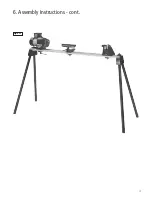
26
11. Troubleshooting
Symptom
Possible Cause
Possible Remedy
Tailstock or tool rest cam locking device not effective.
Excessive noise or vibration from motor / headstock.
Motor slows down / stalls or cuts out when in use.
Motor will not start.
Not connected to power supply.
Faulty fuse or circuit breaker tripped.
Object in the path of workpiece.
Faulty switch / control unit.
Faulty motor.
Excessive pressure being applied to turning tool.
'Dig in' caused by irregular shaped work piece /
poor technique.
Turning tool edge has become dull.
Headstock drive centre not seated correctly.
Faulty motor.
Circuit overloaded by other tools or lighting.
Circuit too long or undersized wires.
Voltage too low.
Circuit breaker does not have sufficient capacity.
Insufficient belt tension allowing motor pulley
to slip.
Loose pulley.
Motor fan cover damaged or loose or making
contact with motor fan.
Incorrect pulley alignment.
Bearing faulty.
Faulty motor bearing.
Machine not correctly assembled.
Incorrect adjustment.
Check connection to power supply and re-try.
Check fuse and replace if necessary.
Check circuit breaker and re-set if necessary
Check that the work piece can rotate freely.
Adjust tool rest so that it is clear of
the workpiece.
Have the switch or control unit inspected and
replaced if necessary.
Have the motor inspected and replaced
if necessary.
Reduce amount of force being exerted on the
turning tool.
Reduce the spindle speed to provide more torque.
Reduce amount of force being exerted on the
turning tool.
Sharpen turning tools regularly.
Sharpen the tool regularly.
Remove drive centre and ensure that the taper
is clean and free from foreign bodies. Re-seat
the drive centre by tapping it firmly in to the
headstock spindle using a soft faced mallet.
Have the motor inspected and replaced
if necessary.
Decrease the load on the circuit by removing or
switching off other tools etc.
Avoid using extension leads. Check that any leads
used are of suitable cross section and diameter.
Have the circuit checked by a qualified electrician.
Have the circuit checked by a qualified electrician.
Have the circuit checked by a qualified electrician.
Check the belt tension and adjust as necessary.
Check for oil or other waste material on the
surface of the pulleys and belt. Clean
as necessary.
Check that retaining screws in both pulleys are
fully tight. Note the procedure outlined in this
manual for correct fitting and adjustment of
pulleys,
section 6
.
Check the fan cover for damage and clearance.
Adjust as necessary.
Check and adjust pulleys as described in
section 6
.
Check both bearings and replace if necessary.
Have the motor inspected and replaced
if necessary.
Check the correct configuration of the kinematic
clamping points as detailed in these assembly
instructions,
section 6
.
Adjust nyloc nut to increase or decrease force
exerted by the cam mechanism as described in
section 6
.





















